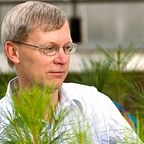Forest Food Chains: Exploring the Intricacies of Ecosystem Dynamics
Forests, with their lush canopies and diverse ecosystems, are a playground for intricate interactions among flora and fauna. The heartbeat of these ecosystems lies in the delicate balance of food chains, where every organism plays a crucial role. In this comprehensive exploration, we delve into diverse forest food chain examples, unraveling the complex web of relationships that sustains life within these verdant landscapes.
## The Basics of Forest Food Chains
Before diving into specific examples, let’s understand the fundamental principles of a forest food chain. At its core, a food chain represents the flow of energy in an ecosystem. It begins with the sun, the primary source of energy, which is harnessed by plants through photosynthesis. From there, the energy cascades through various trophic levels as organisms consume each other.
## Example 1: Deciduous Forest Food Chain
### Sunlight → Oak Tree (Producer) → Caterpillar (Primary Consumer) → Songbird (Secondary Consumer) → Red Fox (Tertiary Consumer)
In a deciduous forest, oak trees stand as majestic producers, capturing sunlight and converting it into energy through photosynthesis. A caterpillar, a primary consumer, feasts on the leaves of the oak tree. This caterpillar becomes the prey for a songbird, a secondary consumer. Finally, a red fox, a tertiary consumer, hunts the songbird, completing the food chain.
## Example 2: Coniferous Forest Food Chain
### Sunlight → Pine Tree (Producer) → Squirrel (Primary Consumer) → Northern Goshawk (Secondary Consumer) → Grey Wolf (Tertiary Consumer)
In a coniferous forest dominated by pine trees, the food chain unfolds differently. The pine tree, as the producer, harnesses sunlight for energy. Squirrels, primary consumers, consume pine seeds. The Northern Goshawk, a formidable predator, preys on the squirrels. At the top of the chain, the grey wolf, a tertiary consumer, may hunt the goshawk, showcasing the intricate connections within this ecosystem.
## Example 3: Tropical Rainforest Food Chain
### Sunlight → Banana Tree (Producer) → Monkey (Primary Consumer) → Python (Secondary Consumer) → Jaguar (Tertiary Consumer)
Within the lush biodiversity of a tropical rainforest, banana trees stand tall as producers, absorbing sunlight for growth. Monkeys, as primary consumers, feast on bananas. A python, a sleek secondary consumer, may capture and consume the monkey. Finally, the jaguar, an apex predator, preys on the python, illustrating the complexity of the tropical rainforest food chain.
## Example 4: Boreal Forest Food Chain
### Sunlight → Spruce Tree (Producer) → Snowshoe Hare (Primary Consumer) → Lynx (Secondary Consumer) → Grey Owl (Tertiary Consumer)
In the frigid landscapes of the boreal forest, spruce trees capture sunlight as producers. Snowshoe hares, primary consumers, nibble on the spruce needles. Lynxes, agile hunters, pursue the hares as secondary consumers. At the top of this cold-weather chain, the grey owl, a tertiary consumer, may hunt the lynx, completing the cycle in this unique ecosystem.
## Example 5: Temperate Rainforest Food Chain
### Sunlight → Redwood Tree (Producer) → Deer (Primary Consumer) → Black Bear (Secondary Consumer) → Cougar (Tertiary Consumer)
In the temperate rainforest, towering redwood trees harness sunlight as producers. Deer, primary consumers, graze on the vegetation around the redwoods. Black bears, formidable omnivores, may feed on deer as secondary consumers. Cougars, as top predators, complete the chain by preying on black bears.
## The Role of Decomposers
It’s important to note that forest ecosystems involve more than just straightforward predator-prey relationships. Decomposers play a crucial role in recycling nutrients. Organisms like fungi and bacteria break down organic matter, returning essential nutrients to the soil. This, in turn, supports the growth of plants, closing the loop in the forest ecosystem.
## Interconnected Food Webs in Forests
While we’ve explored simplified linear food chains, real forest ecosystems are characterized by intricate food webs. These interconnected webs showcase the multiple relationships and dependencies among various species. For instance, a single species might have multiple predators or prey, and some organisms may occupy different trophic levels depending on their life stage.
Consider a scenario in a deciduous forest where insects, birds, and mammals interact with various plant species. A single bird species might consume insects, seeds, and fruits, creating a complex web of connections. Such complexity adds resilience to the ecosystem, ensuring that if one species faces challenges, others can compensate.
## Conservation Implications
Understanding forest food chains is pivotal for conservation efforts. Human activities, climate change, and habitat destruction can disrupt these delicate balances. By comprehending the interconnectedness of species within food chains and webs, conservationists can develop strategies to protect keystone species and maintain the biodiversity crucial for healthy forests.
## Conclusion
Forest food chains are intricate dances of life, where each participant plays a vital role in sustaining the ecosystem. From the towering trees harnessing sunlight to the predators at the top of the trophic pyramid, every organism contributes to the delicate balance of nature. By unraveling the complexities of these food chains, we gain a deeper appreciation for the interconnected web of life within the world’s forests. As stewards of these ecosystems, it is our responsibility to preserve and protect the diversity that makes each forest a unique and thriving tapestry of life.
